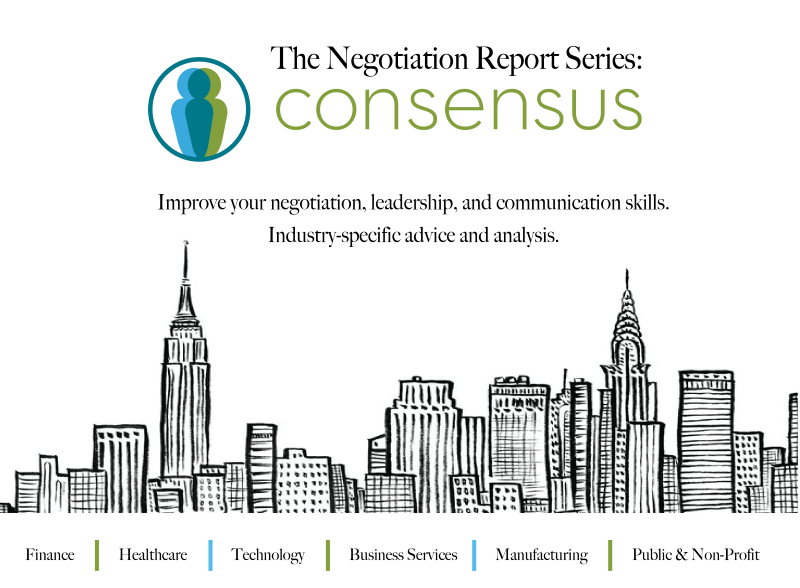Negotiation Report: Healthcare 2

Healthcare Negotiation Report: Administrator-Doctor Relationships
Resolving Disputes between Hospital Administration and Physicians
Healthcare professionals are subject to increased governmental scrutiny and administrative oversight. In an interview with Consensus, one doctor described the growing role of administrators in healthcare industries.
The Growing Role of Administrators
“Doctors have to work increasingly more with administrators. They’re becoming more like our bosses, which is odd because non-physicians can tell us how much to work, our hours, how many patients we see, etc.”
From our perspective, this quote represents a key challenge: addressing personal-identity issues. What the doctor cites as “odd” is actually quite normal in most contexts: employees’ workloads, schedules, and clients are impacted, if not dictated, by management decisions. Still, for the doctor we spoke with, administrator input on her professional activities is inconsistent with her definition of “doctor responsibilities”.
Empathy
Administrators should be sensitive to doctor reactions – when a nerve seems to have been touched, they should find out what evoked the negative reaction. They should be sympathetic to the emotions of their doctors, while standing firm on decisions and decision-making roles. Disaggregating the two allows for more constructive conversation.
For example, an administrator might say, “It seems from your reaction that you don’t like when I assign your schedule. If I were in your shoes, I might feel undermined and disrespected. I might even feel that decisions are being made by someone with inferior perspective and insight. And, if so, I also wouldn’t feel great about it. Is that what you are feeling?” (Allow the doctor to respond. Then pivot with the following:) “Let me share with you why the responsibility for making scheduling decisions was assigned to the administrators instead of to the doctors.”
Self-Analysis
Meanwhile, doctors like the one we quote above should question their own assumptions. Is her experience objectively odd? Certainly, there are many industries in which senior executives oversee functions in which they have little if any expertise. For example, the CEO of Mercedes Benz likely does not know how to design or assemble a world class automobile.
These changes in workplace dynamics bring about new communication challenges for doctors and administrators alike.
Different Priorities
Doctors and administrators may have different priorities, providing fodder for conflicts. “For example,” the doctor explains, “many health insurance companies and government agencies are imposing documentation requirements, such as electronic records, that pull the doctor away from taking care of patients.” In an effort to identify a solution that is acceptable to administrators and doctors alike, new workplace policies and transitions are discussed at meetings attended by both sets of professionals. Unfortunately, the meetings that are organized as forums for constructive dialogue can quickly become heated and unproductive.
Per our interviews with healthcare professionals, often doctors and administrators sit on opposite sides of the table. Each constituent group has leverage over the other. If doctors are non-compliant, administrators can enforce penalties. Conversely, without doctors rendering services, hospitals cannot survive. Each constituency is likely to overestimate their leverage and try to use it if negotiations become particularly hostile.
Our Advice
We offer twelve strategies for a win-win negotiation between healthcare professionals and administrators.
1) Spend at least five minutes building rapport by discussing anything but the matter at hand.
2) Approach the negotiation as a joint problem-solving opportunity. Sit on the same side of the negotiation table to set a tone of collaboration, with doctors and administrators sitting side by side.
3) Identify what the primary goals and secondary goals are for each constituency.
4) Underscore areas of commonality. (Quite often, counterparts are on the same page for 98% of the matters at hand, yet the remaining 2% over which they disagree overshadows the commonality.)
5) Use data to support assertions. Ask the other side how they interpret the data and if they have additional data to inform the situation.
6) Expand the figurative pie of resources before slicing it up. Turn the negotiation into an opportunity for collaboration rather than a fight over resources. Think creatively, and surface new options that satisfy both sides’ goals. Brainstorm these options together, in advance of the meeting, and in separate caucuses.
7) Use independent benchmarks to determine what is “normative” and “fair”.
8) Summarize what you think that the other side is saying. This assures them that you are actively listening to them and that you have a full and accurate understanding of their perspectives.
9) Take a break – cool down, clear your head, process information…before things get out of hand.
10) Describe to yourself your counterpart’s assessment of the situation, as they would describe it to their best friend.
11) Use personal connections to constructively influence your counterpart.
12) Beware of overconfidence if you feel that you are in a position of power. Overconfident negotiators typically do not construct well-researched arguments. Negotiators in positions of power are also less likely to understand the other party’s goals or viewpoint, which stands in the way of jointly identifying mutually-beneficial solutions.
Our recommendation is that both sides adopt these strategies and hold their counterparts to the same standards.
These strategies are a window into the field of collaborative negotiation. Though many doctor-administration disputes can be resolved through roundtable discussion, negotiation strategies are instrumental for large-group discussions held under hostile circumstances.
Related articles: Healthcare Negotiation Report: Dealing with Know-it-all Patients
